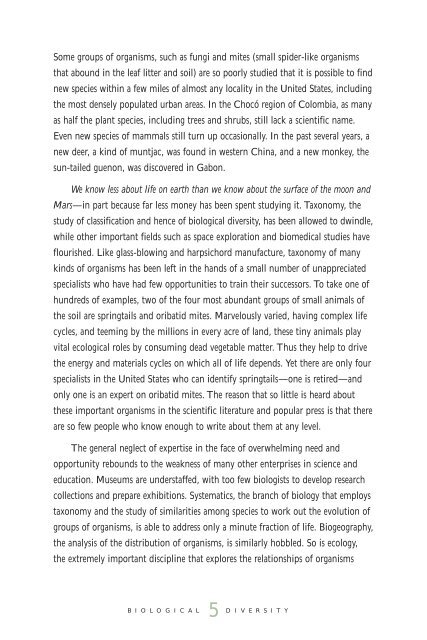Download Biological Diversity - New York State Museum
Download Biological Diversity - New York State Museum
Download Biological Diversity - New York State Museum
You also want an ePaper? Increase the reach of your titles
YUMPU automatically turns print PDFs into web optimized ePapers that Google loves.
Some groups of organisms, such as fungi and mites (small spider-like organisms<br />
that abound in the leaf litter and soil) are so poorly studied that it is possible to find<br />
new species within a few miles of almost any locality in the United <strong>State</strong>s, including<br />
the most densely populated urban areas. In the Chocó region of Colombia, as many<br />
as half the plant species, including trees and shrubs, still lack a scientific name.<br />
Even new species of mammals still turn up occasionally. In the past several years, a<br />
new deer, a kind of muntjac, was found in western China, and a new monkey, the<br />
sun-tailed guenon, was discovered in Gabon.<br />
We know less about life on earth than we know about the surface of the moon and<br />
Mars—in part because far less money has been spent studying it. Taxonomy, the<br />
study of classification and hence of biological diversity, has been allowed to dwindle,<br />
while other important fields such as space exploration and biomedical studies have<br />
flourished. Like glass-blowing and harpsichord manufacture, taxonomy of many<br />
kinds of organisms has been left in the hands of a small number of unappreciated<br />
specialists who have had few opportunities to train their successors. To take one of<br />
hundreds of examples, two of the four most abundant groups of small animals of<br />
the soil are springtails and oribatid mites. Marvelously varied, having complex life<br />
cycles, and teeming by the millions in every acre of land, these tiny animals play<br />
vital ecological roles by consuming dead vegetable matter. Thus they help to drive<br />
the energy and materials cycles on which all of life depends. Yet there are only four<br />
specialists in the United <strong>State</strong>s who can identify springtails—one is retired—and<br />
only one is an expert on oribatid mites. The reason that so little is heard about<br />
these important organisms in the scientific literature and popular press is that there<br />
are so few people who know enough to write about them at any level.<br />
The general neglect of expertise in the face of overwhelming need and<br />
opportunity rebounds to the weakness of many other enterprises in science and<br />
education. <strong>Museum</strong>s are understaffed, with too few biologists to develop research<br />
collections and prepare exhibitions. Systematics, the branch of biology that employs<br />
taxonomy and the study of similarities among species to work out the evolution of<br />
groups of organisms, is able to address only a minute fraction of life. Biogeography,<br />
the analysis of the distribution of organisms, is similarly hobbled. So is ecology,<br />
the extremely important discipline that explores the relationships of organisms<br />
B i o l o g i c a l<br />
5 D i v e r s i t y
















